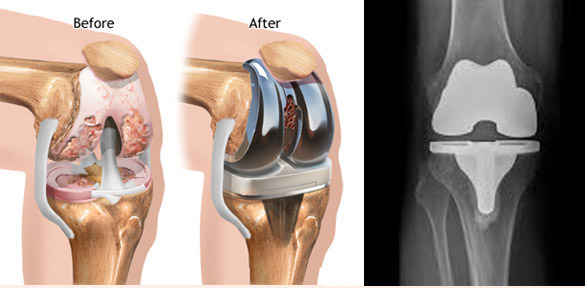-
Mon - Sat
08:00am - 08:00pm

There are several ways to treat the pain caused by arthritis. When all the conservative methods fails to overcome the problem replacement surgery is only way to treat the pain. The decision to have knee replacement surgery should be made after consulting your doctor and complete understanding of procedure at A+OSM.
In knee replacement surgery, the bone surfaces and cartilage that have been damaged by arthritis are shaved off and replaced with artificial surfaces made of metal and a plastic material. We call these artificial surfaces “implants,” or “prosthesis.”
There are various options depending on the area of involvement and the extent of involvement.

If a small area of joint is involved a partial replacement can be performed also known as Uni-compartment knee replacement.
But if there are large area of involvement and the alignment is very bad than it is safer to go for Total Knee replacement.
In total knee replacement or TKR a small amounts of the bone surface are removed from the front, side and back of the femur (thigh bone). This shapes the bone so the implants will fit properly. The amount of bone that is removed depends on the amount of bone that has been damaged by the arthritis.
A small portion of the top surface of the tibia(leg bone) is also removed, making the end of the bone flat.
The back surface of the patella (kneecap) is also removed.

An implant is attached to each of the three bones. These implants are designed in such a way that the knee joint will move in same fashion as that the original knee joint moved when it was healthy. The implants are attached using a special kind of cement for bones.
The implant that fits over the end of the femur is made of metal. Its surface is rounded and very smooth, covering the front and back of the bone as well as the end.
Various metal and type of implants are available
Common material is chromium-Cobalt, but with advancement titanium and carbon are also used.
Modern day implants are designed such that they are able to give almost full range of movement.
With new patient specific implants there is a ease of fitting the exact size matching your original knees. Even gender specific knees are available to address the anatomical variation in knees of ladies.
You are only in bed for one day with good patient controlled analgesia to give complete relief from pain.
Check x-ray is performed and you can get up and mobilise from second postoperative day

After TKR generally patient is made to stand the next day of the surgery,with support(walker & long knee braces). Also knee bending is initiated with the help of CPM(continuous passive movement) Patient walk a few steps next day or day 2 of the surgery.
By and large between 3-4 days patient is allowed to walk in the corridor by himself/herself & discharged home.
Stitches are removed on 14th day of the surgery and supervised rehab is started.
Rehabilitation is a most important tool to get good functioning of knee after TKR. Knee bending is progressively measured and patient is asked to walk with stick max up to 6 weeks.
Complete independent ambulation (walking ) is advised by 6-8 weeks and patient is quite comfortable by 3 months, by which time all pain swelling, and discomfort settles down. Generally by this time one is ready to drive by himself/herself.
After knee replacement by three months patient is able to walk long distance, able to do stairs with ease, able to do all day to day activities without pain, manage all personal hygiene without any help.
Squatting and sitting cross legged is what needs to be avoided.
If looked after well and supervised by medical team your knee replacement can easily last a life time.